Biomedical Engineering Reference
In-Depth Information
(k
Ω
)
ρ
8
T
= 300 K
4
T
= 30 mK
-50
-25
0
25
50
V
g
(V)
Fig. 1.32
Typical temperature and gate voltage dependence of graphene resistivity
path for ballistic transport is around 300 nm, and the carrier mobility takes a typical
value of 15;000 cm
2
V
1
s
1
at room temperature (
Geim and Novoselov 2007
)but
can increase at 200;000 cm
2
V
1
s
1
in suspended graphene sheets with a carrier
concentration of n
D
2
10
11
cm
2
(
Bolotin et al. 2008
). The graphene resistivity
has only a slow variation with temperature, especially in samples with low mobility,
but depends strongly on the gate voltage, as illustrated in Fig.
1.32
.Thisbehavior
contrasts the strong resistivity dependence on temperature in other semiconductors
or metals. The weak dependence of resistivity on temperature is determined by the
dominant scattering mechanism, caused in low-mobility samples by static impurities
and in high-density samples by residual electron-phonon scattering (
Tan et al 2007
).
In common semiconductors, the electron and hole transport are described by
two independent Schrodinger equations, whereas in graphene, the electron and
hole states are correlated through the so-called charge-conjugation symmetry (or
chirality), and a Dirac-like equation for massless particles is needed to model their
behavior. In particular, both electrons and holes in graphene are characterized by a
linear dispersion relation, given by
E
D˙j„
k
j
v
F
;
(1.31)
where E is the energy of charge carriers with wavevector
k
y
,and
v
F
is
the Fermi velocity. In Fig.
1.33
, which illustrates this linear dispersion, the positive
sign in (
1.31
) is assigned to electrons, while the negative sign corresponds to holes.
The distinctive dispersion relation (
1.31
) shows that the valence and conduction
bands touch each other in a point termed Dirac point, i.e., graphene is a gapless
semiconductor.
A linear dispersion relation such as that in graphene is met only in photons
propagating in vacuum, for which E
D„
!
D
hc=, with c the speed of
light. Note that the two situations correspond to completely different physical
systems: graphene is a 2D gas of massless fermions, whereas photons are bosons.
k D i
k
x
Cj





Search WWH ::

Custom Search